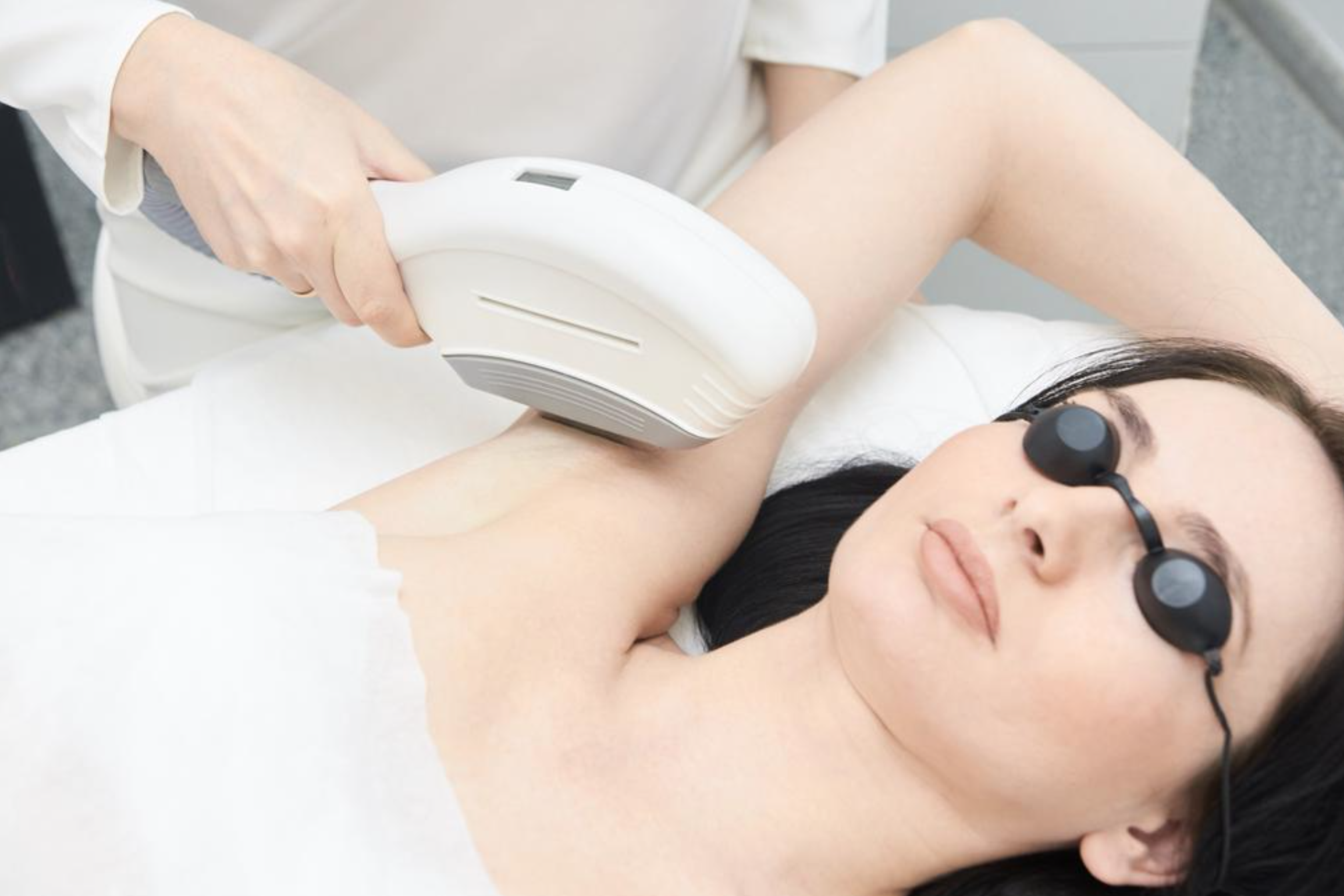DEPILATION WITH SHR (SUPER HAIR REMOVAL)

SHR AND IPL - HOW ARE THE TWO PROCEDURES DIFFERENT?
As the name suggests, SHR (Super Hair Removal) is currently the most effective way to get rid of excess hair. It can also be used effectively for photorejuvenation, skin rejuvenation, pigment spots, dilated blood vessels, and acne.
The method combines the advantages of IPL, RF and laser technologies. It is faster, less painful and more effective than other IPL, laser or E-light technology. The treatments involve much less discomfort and are gentler on the skin.
The specialty of the method is high pulse repetition using low energy. Instead of - as we are used to with IPl - flashing the hairs to be treated with high intensity, the device gradually heats the skin or the hair follicles with minimal discomfort. We can achieve maximum efficiency without damaging the skin surface.
With the SHR, in addition to the gradual heat release, the treatment is really comfortable and maximally effective thanks to the cooling of the treatment head. No pain relief is required.
For SHR treatments, we use the In-motion technique, which means continuous movement of the treatment head. In this case, the treatment head is not moved one after the other from skin surface to skin surface, but is pulled evenly and slowly, so the treatment is faster and more comfortable. With the help of the In-Motion technology, we can eliminate the missed, spotty hair-free areas that appear after frequent treatments, since there will be no accidentally missed parts by continuously pulling the treatment head.
SHR, painless hair removal method
This method of permanent hair removal is almost completely painless. If it is used on a part of the body that is covered with a lot of hair, you can feel the pulsation of the light and some warmth. The slight stinging and discomfort that can be felt during the laser and IPL treatment does not occur when using the SHR method. As with other permanent hair removal methods, a thin layer of contact gel must be applied with SHR, which can be used to cool the treated area. The SHR method can be applied to all parts of the body, except for the immediate area around the eyes.
All hair and skin types can be treated with SHR technology
Compared to other laser and IPL hair removal methods, the great advantage of SHR technology is that hair and skin color do not play such a significant role. While the older methods required fair skin and darker hair color for successful treatment, the SHR method is not so strict. Of course, the best result will be on a combination of light skin and dark hair color, however, the SHR technology does not only depend on the melanin level, but also on the protein content of the stem cell. For this reason, the treatment should not be so difficult for people with darker skin type and lighter hair color.
What is the difference between the technologies?
Conventional laser or IPL technologies use short pulses of approximately 2-300 milliseconds and deliver enormous amounts of energy (12-120 Joules) per square centimeter. The energy penetrates through the hair to its root with the help of the melanin content, where the temperature can reach 65-72°C. Skin and red blood cells have the same absorption factor as melanin and therefore absorb the heat generated by high energy lasers and IPLs.
SHR technology partially uses melanin (50%). Conventional devices do not use SHR technology, they merely transport the energy through the melanin content into the hair follicle. The SHR gently transports the energy through the skin and through the pigment of the hair to the hair follicle.
Research shows that the slow but long-lasting heating process is significantly more effective in permanent hair removal than the high and short energy level processes. Therefore, when the SHR device passes through the tissue 6-10X, use a low energy level, but a high number of repetitions (up to 10 Hz, 10X/sec) instead of the traditional method (high energy pulses). Thus, the melanin of the hair, like the tissue of the stem cell, is heated with low energy, using slow movements for longer periods (90 sec), at a pleasant temperature (45°C). The SHR method can be a successful treatment method for lighter hair, since the pigment content of the hair is only secondary.
Which areas can we treat?
Any area of the body can be treated. However, it is recommended to test the SHR in a small area before treatment to avoid later side effects. So we can treat all areas to be depilated, even between the eyebrows or on the entire leg. Rejuvenation, pigment spot lightening, hair removal, or vascular treatments can be performed on the entire face (except eyes).
How many treatments are needed?
Up until now, hairs could only be treated during the growth phase, which meant only 20-30% of the total amount of hair. Hairs in the telogen phase can also be treated with the SHR method. Permanent hairlessness requires approximately 5-8 treatments.
How much time should elapse between two treatments?
4-6 weeks should elapse between two treatments.
What side effects should be expected?
Some parts of the body have more sensitive skin than others. This can cause reddening of the skin. This redness disappears a few hours after the treatment, but it can be more intense if the skin is treated in the sun.
IPL treatment is still one of the most effective permanent hair removal methods. This method has been perfected for more than 20 years, which now allows us to get rid of unnecessary hair in a much shorter time, without pain or discomfort. In our salon, the latest optical hair removal system using OPT-SHR magnetic technology combines magnetic energy with the intense pulse light of IPL, which is the perfect solution for permanent hair removal, but also for the removal of acne, pigment spots, capillary dilation, and wrinkles.
SHR permanent hair removal / Photoepilation
SHR heats the hair follicles for a longer time, but with less energy, than the traditional IPL or E-light devices, which is why it is not unpleasant, it is also effective on blonde hair, and there is no need to protect yourself from the sun for weeks.
The energy of the light beam is absorbed in the pigment content of the hair and turns into heat, neutralizing it. Can be used on mustache, beard, armpits, bikini line, back, legs, nape, etc. for hair removal, for both men and women. The procedure only affects ingrown hairs, so avoid hair removal procedures during the treatment. Instead of shaving, it is a better solution to cut the troublesome strands with a pair of scissors. Please come to the treatment with 1-2 mm of hair in the area to be treated. To achieve lasting results, depending on the area, approx. 4 - 8 treatments are required.
Before permanent hair removal/ treatment:
Shave the hair in the area to be treated before the SHR flash treatment 4-5 days before the treatment (except on the face, do not shave there, but cut it with nail clippers), because the flash treatment is most effective for short-cut hair. The optimal hair length: 1-2 mm.
Avoid tweezing hair removal, waxing, bleaching, and the use of hair removal creams!
Treatment cannot be performed on very tanned, especially burnt skin. Refrain from sunbathing, don't sunbathe, don't use self-tanning products four weeks before the first treatment. If you will inevitably be in the sun, use a sun protection product with a factor of at least 50 on the surfaces to be treated.
After IPL treatment:
Protect the treated area from heat for 24 hours! Do not go to a sauna, infrared sauna, steam cabin, or take a hot bath! Do not exercise intensely!
Do not sunbathe or sunbathe for 14 days: If you do have to be in the sun, use a 30-50 factor sunscreen on the treated area.
Do not rub, scratch or pinch the treated area, just care for it gently! After bathing or showering, gently absorb the moisture from the skin surface with a towel.
A small percentage of patients experience peeling. Peeling is similar to the effects of sunburn. It is not recommended to remove the peeling skin as it may lead to spotting.
If any unexpected problem occurs after treatment, call the person performing the treatment!
Certain medications sensitize the skin to light, so IPL / flash light treatment is contraindicated while taking them, as the skin may become stained. The treatment cannot be performed if you are taking the following medications or have existing contraindications!
Medications that can cause photosensitivity (but not limited to):
Amiloride, Almagel, Antagel, Apranax, Adalat, Vitamin A
Blockacin
Cordarone, Ciprobay, Cordaflex, Corinfar, Chlorognin
Doxycycline, Doxyhexal, Dilzem, Dilzem Retard, Diphedan, Delogil, Dacarbasin, Dalacin-C,-T
Erpozid, Erpozid Forte, Estraderm, Estrofem, Erazon cream, Efudix ointment
Furosemide, Fluoro-Uracil inj., Feldene
Gricin, Griseofulvin, Geroxalin
Hypothiazide, Hibernal, Haloperidol, Huma-Profene
Isonicide, Ibuprofen
Kliogest
Librium
Methotrexate, Melleril, Malugel, Microdox
Nalidixic acid, Nifedipine, Nifedipine
Ovestin, Oxycort spray
Paranteral, Phenylbuthazon ointment, Pipolphen, Potesept, Phenothiazine
Retin-A cream, Rheosolon, Regaine, Roaccutane
Sulfoguanidine, Streptomycin, Syntestrin,
Tetran, Tarivid, Teperin, Tensiomin
Vibramycin
Xanax
+ Some oral contraceptives
